What the Dutch Car Market Is Saying: Lessons in Trust, Buzz, and Brand Health
If you want to understand how people really feel about a brand, don’t look at the billboards — listen to the conversations happening online.
The Dutch automotive market is a perfect example of how fast opinions shift and how deeply emotion and trust shape consumer behavior.
Between January and November 2025, we at SentiOne Listen tuned in to what drivers and enthusiasts were saying about six major car brands 👉 Volkswagen, BMW, Kia, Toyota, Škoda, and Renault.
We didn’t just count mentions. We explored the stories behind them: what drove spikes in attention, where emotions flared, and which brands earned lasting trust.
The result? A portrait of a market in motion — one where visibility and reputation dance to very different rhythms.
The State of Trust: Who’s in the Driver’s Seat

Every car brand has its own journey, but when it comes to brand health — that blend of trust, admiration, and loyalty — not all are cruising at the same speed.
Toyota and Renault emerge as reliable co-pilots in consumers’ minds, both enjoying solid reputations and strong goodwill.
Volkswagen, BMW, and Škoda find themselves in the middle lane — visible, yes, but balancing enthusiasm with skepticism.
And then there’s Kia: bold, loud, viral, but struggling to turn attention into affection.
Visibility without trust is like horsepower without traction.
It makes noise, but it doesn’t move you forward.
Buzz vs. Reach: The Visibility Illusion
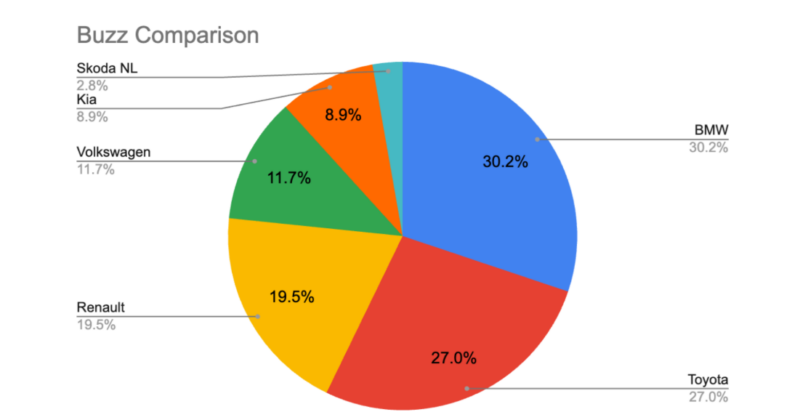
If buzz were everything, BMW and Toyota would be clear winners. They dominate the share of voice, sparking more than half of all online conversations in the segment.
But the real surprise lies with Kia.
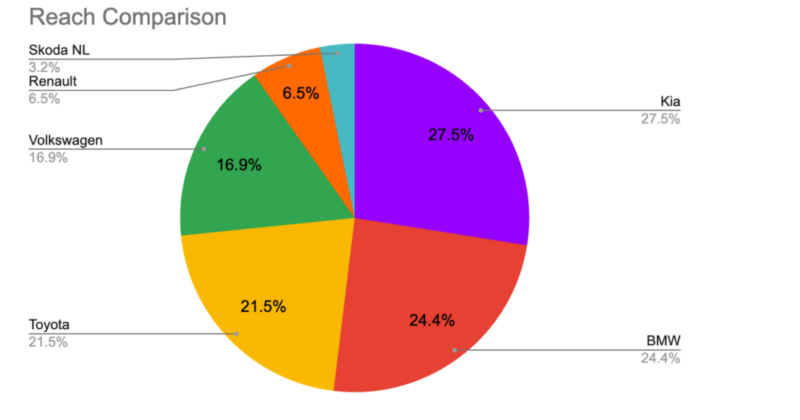
Despite having less than 9% of total buzz, Kia’s posts reach farther than anyone else’s — accounting for over 27% of total audience exposure.
A perfect example of how viral moments, even if few, can echo loudly. Yet, as our sentiment data shows, reach alone doesn’t guarantee warmth.
Kia’s vast visibility hides a cold truth: much of the chatter lacks trust.
In the digital world, numbers tell you how many people are watching, but not whether they like what they see.
The Stories Behind the Spikes
Each brand’s conversation spikes tell their own story — a blend of marketing wins, cultural moments, and unexpected turns.
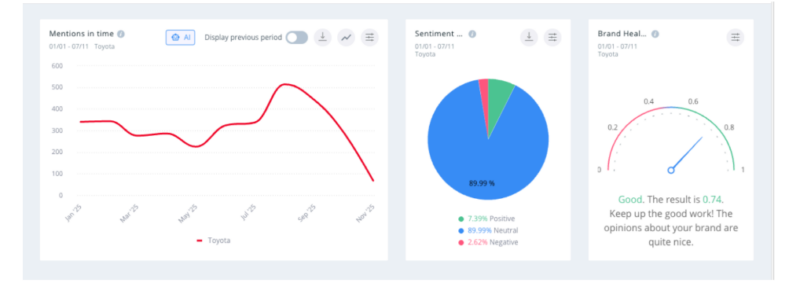
Toyota celebrated its 60th anniversary in Aruba with a nostalgic nod to its legacy, while its hybrid SUVs (like the Corolla Cross and Raize) reinforced its reputation for reliability and innovation. Add in robotics projects, motorsport buzz, and community trivia campaigns — and it’s clear why Toyota consistently leads in brand health.
Heritage met innovation 👉 and consumers loved it.
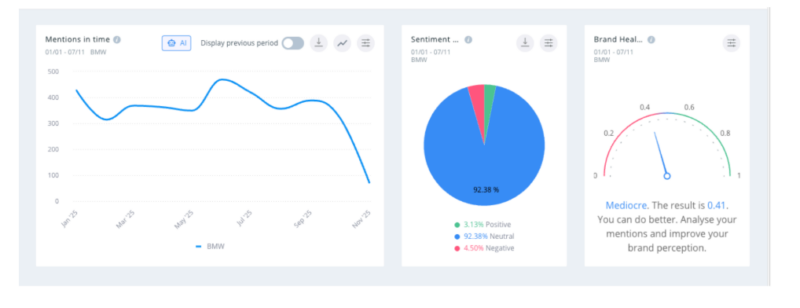
BMW, on the other hand, raced into attention through motorsport dominance — from the Nürburgring 24h to the Spa 24h. Electric launches and tire partnerships with Dunlop elevated its innovation story, but fans’ mixed feelings about performance compared to rivals like Porsche and Mercedes kept sentiment from soaring.
BMW is visible, yes, but admiration doesn’t always keep pace with its speedometer.
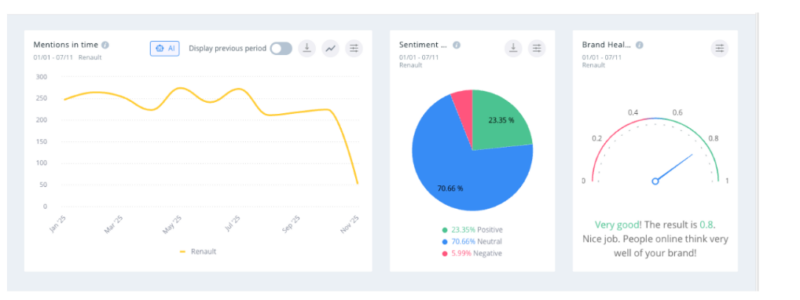
Renault’s story is one of ambition and contrast. The Renault 5 E-Tech and Alpine A290 models tied the brand to sustainability and progress, while financial news of a €2.2B loss pulled sentiment back down to earth. The F1 Alpine team generated buzz, but performance debates split fans.
The result? Strong brand health, but modest reach — a brand loved deeply by those who talk about it, but not always loudly.
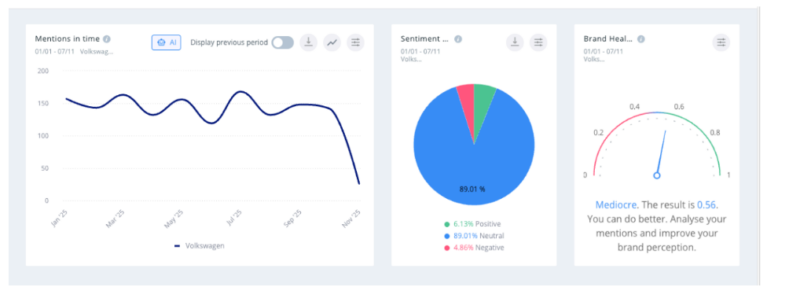
Volkswagen continues its battle between innovation and history. Mentions of its ID.3 EV and Mobileye partnership painted it as a serious player in the electric future. Yet, periodic resurfacing of historical associations reminded us how old narratives can reappear in unexpected ways.
VW’s reach is vast, but sentiment remains volatile — a reminder that even legacy brands must constantly steer the conversation.
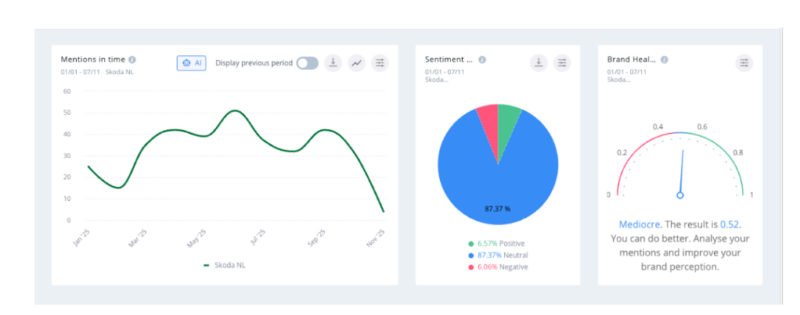
Škoda, the quiet achiever, maintained a steady hum of positive mentions centered around reliability and rally success. But low visibility — just over 3% of reach — means many consumers simply aren’t part of the conversation.
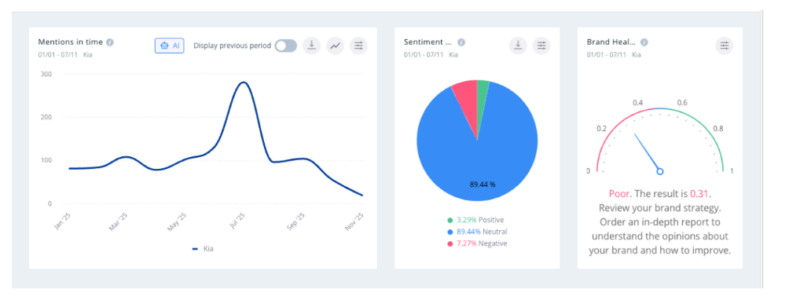
And Kia? Its name traveled far and wide through social virality, TikTok trends, and gaming crossovers. Yet beneath the surface, skepticism runs high. The brand wins attention, not affection — an echo chamber of visibility without trust.
Sentiment: The True Currency of Trust
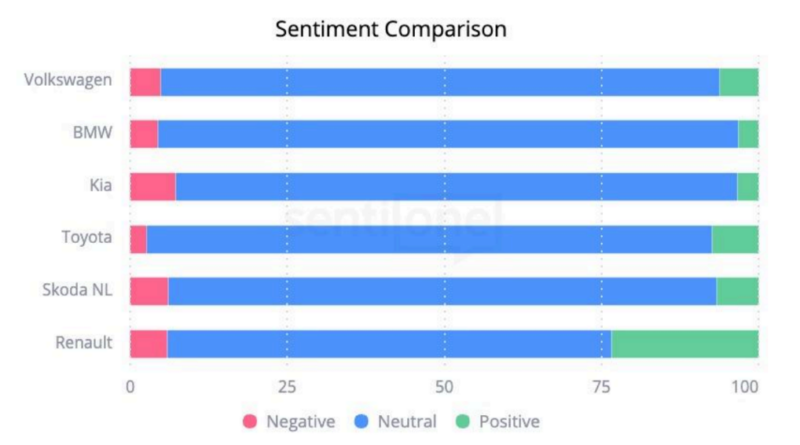
Across the board, neutral mentions dominate. Most people talk about cars the way they talk about the weather — factual, descriptive, fleeting.
But beneath that, emotional undercurrents define the winners and the worriers.
Toyota and Renault lead in positivity.
Škoda and Kia face more negativity than praise.
The rest — Volkswagen and BMW — live in the complex middle, where admiration and criticism intertwine.
In a world flooded with content, it’s not the volume of conversation that builds brands.
It’s the tone of it.
What Every Brand Can Learn
The data from the Dutch automotive landscape isn’t just about cars. It’s about human perception.
- 🚗 Reach doesn’t equal reputation. Kia’s virality shows that being seen isn’t the same as being trusted.
- ❤️ Consistency wins hearts. Toyota’s balance of innovation, heritage, and engagement proves that brand love is earned, not engineered.
- 🧭 Hidden narratives shape risk. Volkswagen’s ongoing image battle reminds us that the past can still whisper into the present.
- ⚡ Buzz without affection is fragile. BMW’s fan-driven spikes show that excitement must translate into emotional loyalty.
- 🔍 Small communities hold big value. Škoda’s understated advocates reveal how even quiet voices can become powerful ambassadors.
- 📰 External events matter. Renault’s financial headlines show how news cycles can shape, or shake, brand reputation overnight.
The Road Ahead: Why Listening Matters
The Dutch automotive story reminds us of something crucial: numbers alone don’t tell us what’s real.
🔴 Mentions show you what happened.
🟡 Sentiment explains why it happened.
🟢 Context reveals what to do next.
That’s the power of social listening.
It’s not just about monitoring noise — it’s about understanding meaning.
For brands in fast-moving markets, where consumer trust can shift as quickly as traffic lights, that understanding isn’t a luxury — it’s a strategy.
Because in the end, conversations don’t just reflect reputation. They create it.
And the brands that listen closely will always have the advantage.



